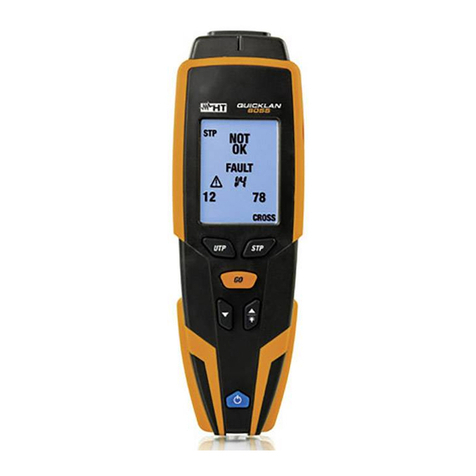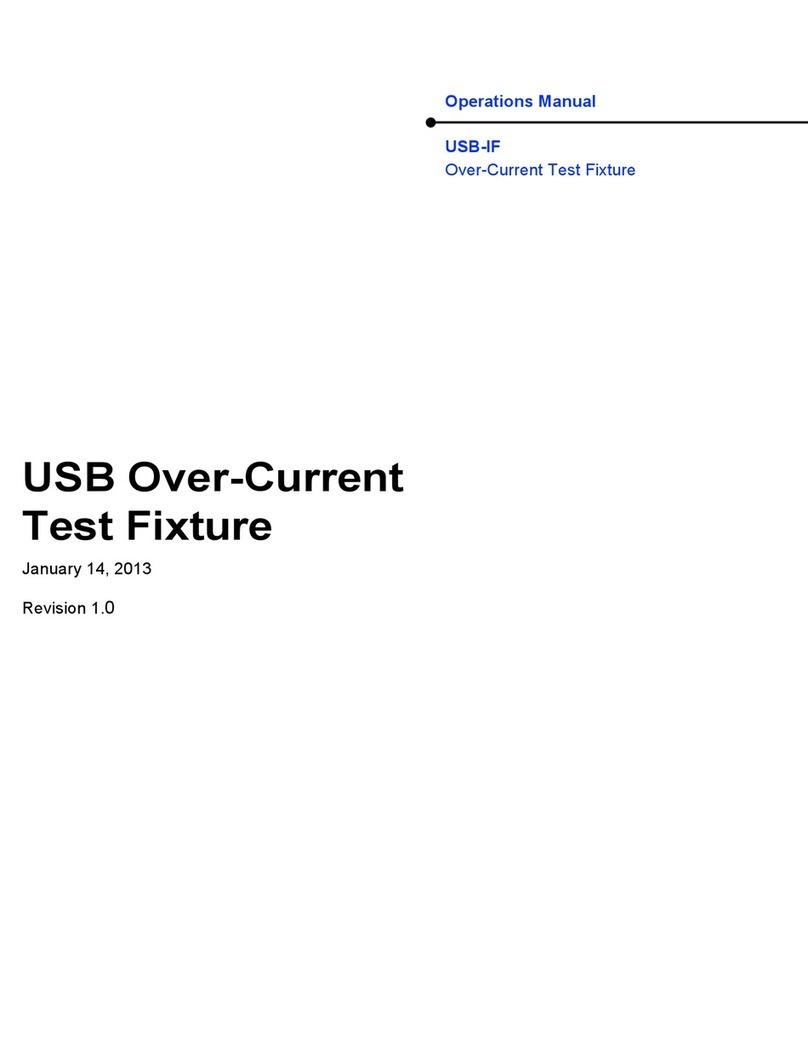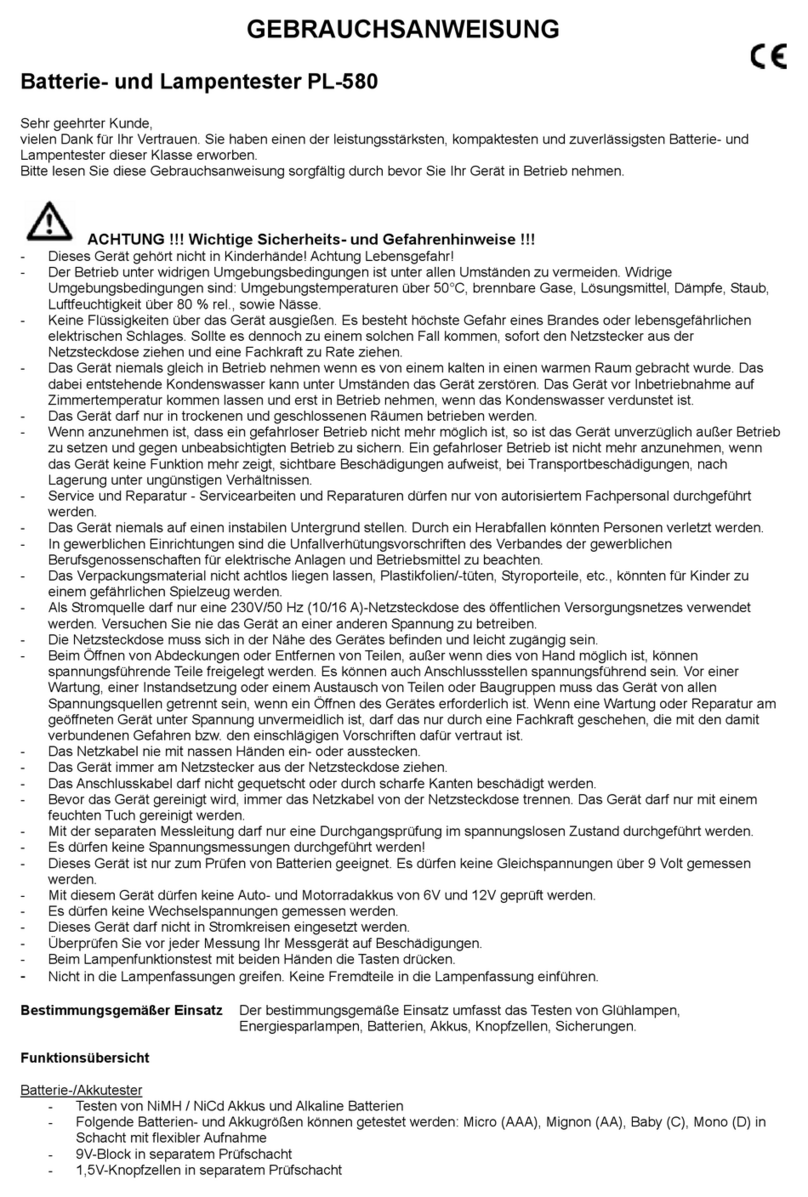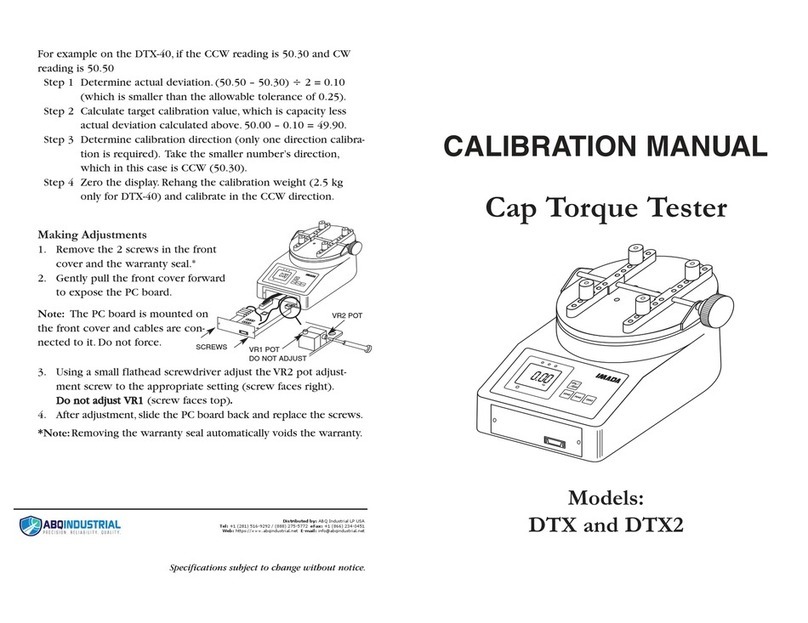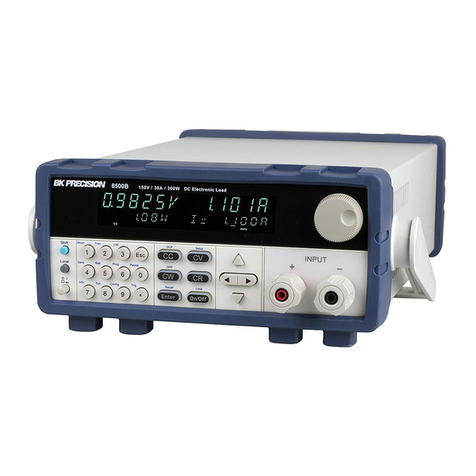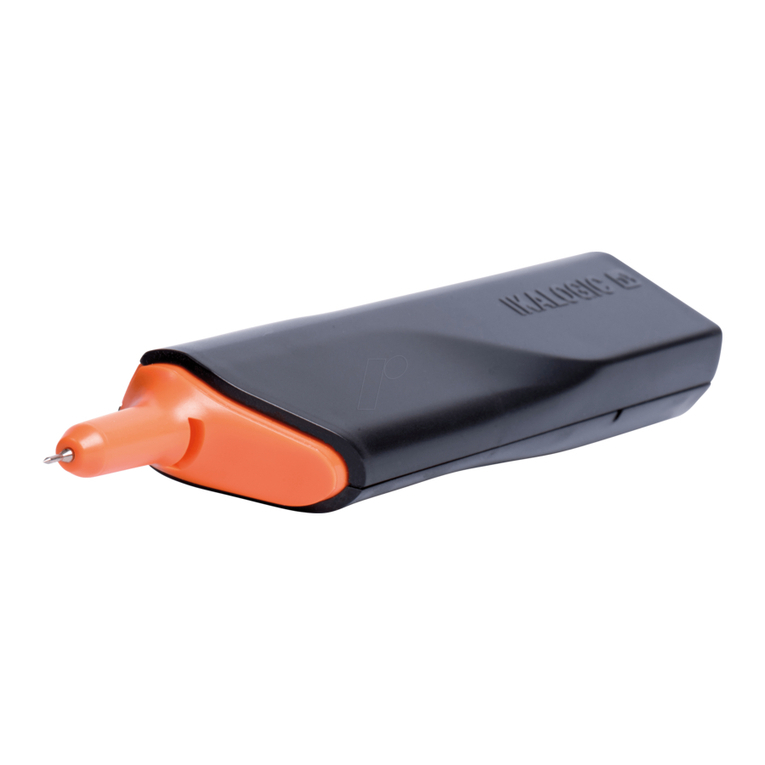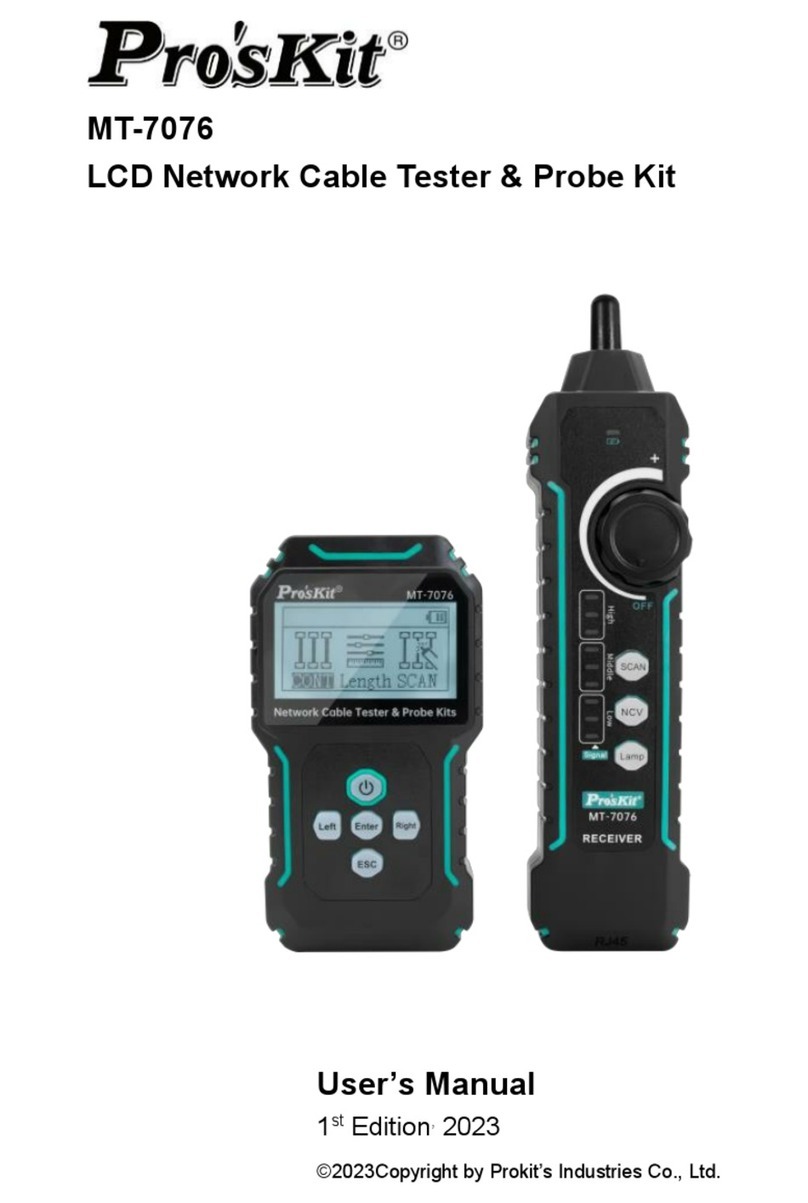HT Instruments HT8051 User manual

Copyright HT ITALIA 2012 Release EN 1.00 - 17/12/2012
ENGLISH
User manual

HT8051
EN - 1
Table of contents:
1.PRECAUTIONS AND SAFETY MEASURES...............................................................2
1.1.Preliminary instructions .........................................................................................2
1.2.During use.............................................................................................................3
1.3.After use................................................................................................................3
1.4.Definition of measurement (overvoltage) category................................................3
2.GENERAL DESCRIPTION...........................................................................................4
3.PREPARATION FOR USE...........................................................................................4
3.1.Initial checks..........................................................................................................4
3.2.Instrument power supply .......................................................................................4
3.3.Calibration .............................................................................................................4
3.4.Storage..................................................................................................................4
4.OPERATING INSTRUCTIONS.....................................................................................5
4.1.Instrument description...........................................................................................5
4.2.Description of function keys and initial settings .....................................................6
4.2.1.key .......................................................................................................................... 6
4.2.2.0-100% key.................................................................................................................. 6
4.2.3.25%/ key .................................................................................................................. 6
4.2.4.MODE key.................................................................................................................... 6
4.2.5.key ................................................................................................................... 7
4.2.6.Adjuster knob............................................................................................................... 7
4.2.7.Setting measuring ranges for output current................................................................ 7
4.2.8.Adjusting and disabling the Auto Power OFF function................................................. 7
4.3.Description of measuring functions........................................................................8
4.3.1.DC Voltage measurement............................................................................................ 8
4.3.2.DC Voltage generation................................................................................................. 9
4.3.3.DC Current measurement.......................................................................................... 10
4.3.4.DC Current generation............................................................................................... 11
4.3.5.Measuring output DC current from external transducers (Loop)................................ 12
4.3.6.Simulation of a transducer ......................................................................................... 13
5.MAINTENANCE .........................................................................................................14
5.1.General information.............................................................................................14
5.2.Recharging the internal battery............................................................................14
5.3.Cleaning the instrument.......................................................................................14
5.4.End of life ............................................................................................................14
6.TECHNICAL SPECIFICATIONS ................................................................................15
6.1.Technical characteristics .....................................................................................15
6.2.General characteristics........................................................................................16
6.2.1.Reference standards.................................................................................................. 16
6.2.2.General characteristics .............................................................................................. 16
6.3.Environment ........................................................................................................16
6.3.1.Environmental conditions for use............................................................................... 16
6.4.Accessories.........................................................................................................16
6.4.1.Accessories provided................................................................................................. 16
7.SERVICE....................................................................................................................17
7.1.Warranty conditions.............................................................................................17
7.2.Service ................................................................................................................17

HT8051
EN - 2
1. PRECAUTIONS AND SAFETY MEASURES
The instrument has been designed in compliance with directive IEC/EN61010-1 relevant to
electronic measuring instruments. For your safety and in order to prevent damaging the
instrument, please carefully follow the procedures described in this manual and read all
notes preceded by the symbol with the utmost attention.
Before and after carrying out the measurements, carefully observe the following
instructions:
Do not carry out any measurement in humid environments.
Do not carry out any measurements in case gas, explosive materials or flammables are
present, or in dusty environments.
Avoid any contact with the circuit being measured if no measurements are being
carried out.
Avoid contact with exposed metal parts, with unused measuring probes, etc.
Do not carry out any measurement in case you find anomalies in the instrument such
as deformation, substance leaks, absence of display on the screen, etc.
Never apply a voltage exceeding 30V between any pair of inputs or between an input
and the grounding in order to prevent possible electrical shocks and any damage to the
instrument.
In this manual, and on the instrument, the following symbols are used:
CAUTION: observe the instructions given in this manual; improper use could
damage the instrument or its components.
Double-insulated meter.
Connection to earth
1.1. PRELIMINARY INSTRUCTIONS
This instrument has been designed for use in environments of pollution degree 2.
It can be used to measure DC VOLTAGE and DC CURRENT.
We recommend following the normal safety rules devised to protect the user against
dangerous currents and the instrument against incorrect use.
Only the leads and the accessories supplied with the instrument guarantee compliance
with the safety standards. They must be in good conditions and replaced with identical
models, when necessary.
Do not test circuits exceeding the specified voltage limits.
Do not perform any test under environmental conditions exceeding the limits indicated
in § 6.2.1.
Check that the battery is correctly inserted.
Before connecting the leads to the circuit being measured, check that the instrument
has been correctly set in order to prevent any damage to the instrument.

HT8051
EN - 3
1.2. DURING USE
Please carefully read the following recommendations and instructions:
CAUTION
Failure to comply with the caution notes and/or instructions may damage
the instrument and/or its components or be a source of danger for the
operator.
Before selecting a measuring function, disconnect the test leads from the circuit under
test.
When the instrument is connected to the circuit under test, do not touch any unused
terminal.
When connecting the cables, always connect the “COM” terminal first, then the
“Positive” terminal. When disconnecting the cables, always disconnect the “Positive”
terminal first, then the “COM” terminal.
Do not apply a voltage exceeding 30V between the inputs of the instrument in
order to prevent possible damage to the instrument.
1.3. AFTER USE
When measurement is complete, press the key to switch off the instrument.
If you expect not to use the instrument for a long period, remove the battery.
1.4. DEFINITION OF MEASUREMENT (OVERVOLTAGE) CATEGORY
Standard “IEC/EN61010-1: Safety requirements for electrical equipment for measurement,
control and laboratory use, Part 1: General requirements” defines what measurement
category, commonly called overvoltage category, is. § 6.7.4: Measured circuits, reads:
(OMISSIS)
Circuits are divided into the following measurement categories:
Measurement category IV is for measurements performed at the source of the low-
voltage installation.
Examples are electricity meters and measurements on primary overcurrent protection
devices and ripple control units.
Measurement category III is for measurements performed on installations inside
buildings.
Examples are measurements on distribution boards, circuit breakers, wiring, including
cables, bus-bars, junction boxes, switches, socket-outlets in the fixed installation, and
equipment for industrial use and some other equipment, for example, stationary motors
with permanent connection to fixed installation.
Measurement category II is for measurements performed on circuits directly
connected to the low-voltage installation
Examples are measurements on household appliances, portable tools and similar
equipment.
Measurement category I is for measurements performed on circuits not directly
connected to MAINS.
Examples are measurements on circuits not derived from MAINS, and specially
protected (internal) MAINS-derived circuits. In the latter case, transient stresses are
variable; for that reason, the standard requires that the transient withstand capability of
the equipment is made known to the user.

HT8051
EN - 4
2. GENERAL DESCRIPTION
The instrument HT8051 carries out the following measurements:
Voltage measurement up to 10V DC
Current measurement up to 24mA DC
Voltage generation with amplitude up to 100mV DC and 10V DC
Current generation with amplitude up to 24mA DC with display in mAand %
Current and voltage generation with selectable ramp outputs
Measuring output current of transducers (Loop)
Simulation of an external transducer
On the front part of the instrument there are some function keys (see § 4.2) for selecting
the type of operation. The selected quantity appears on the display with indication of the
measuring unit and the enabled functions.
3. PREPARATION FOR USE
3.1. INITIAL CHECKS
Before shipping, the instrument has been checked from an electric as well as mechanical
point of view. All possible precautions have been taken so that the instrument is delivered
undamaged.
However, we recommend generally checking the instrument in order to detect possible
damage suffered during transport. In case anomalies are found, immediately contact the
forwarding agent.
We also recommend checking that the packaging contains all components indicated in §
6.4. In case of discrepancy, please contact the Dealer.
In case the instrument should be returned, please follow the instructions given in § 7.
3.2. INSTRUMENT POWER SUPPLY
The instrument is powered by a single 1x7.4V rechargeable Li-ION battery included in the
package. The “ ” symbol appears on the display when the battery is flat. To recharge the
battery using the supplied battery charger, please refer to § 5.2.
3.3. CALIBRATION
The instrument has the technical specifications described in this manual. The instrument’s
performance is guaranteed for 12 months.
3.4. STORAGE
In order to guarantee precise measurement, after a long storage time under extreme
environmental conditions, wait for the instrument to come back to normal conditions (see §
6.2.1).

HT8051
EN - 5
4. OPERATING INSTRUCTIONS
4.1. INSTRUMENT DESCRIPTION
CAPTION:
1. Input terminals Loop, mA,
COM, mV/V
2. LCD display
3. Key
4. 0-100% key
5. 25%/ key
6. MODE key
7. key
8. Adjuster knob
Fig. 1: Instrument description
CAPTION:
1. Operating mode indicators
2. Auto Power OFF symbol
3. Low battery indication
4. Measuring unit indications
5. Main display
6. Ramp function indicators
7. Signal level indicators
8. Secondary display
9. Used inputs’ indicators
Fig. 2: Display description

HT8051
EN - 6
4.2. DESCRIPTION OF FUNCTION KEYS AND INITIAL SETTINGS
4.2.1. key
Pressing this key turns on and off the instrument. The last selected function is indicated on
the display.
4.2.2. 0-100% key
In operating modes SOUR mA (see § 4.3.4), SIMU mA (see § 4.3.6), OUT V and OUT mV
(see § 4.3.2) pressing this key allows quickly setting the initial (0mA or 4mA) and final
(20mA) values of the output generated current, the initial (0.00mV) and final (100.00mV)
values and the initial (0.000V) and final (10.000V) values of the output generated voltage.
The percentage values “0.0%” and “100%” appear on the secondary display. The
displayed value can always be modified by using the adjuster (see § 4.2.6). The “0%” and
“100%” indication are shown at display.
CAUTION
The instrument CANNOT be used for managing measurements
(MEASURE) and signal generation (SOURCE) at the same time.
4.2.3. 25%/ key
In operating modes SOUR mA (see § 4.3.4) and SIMU mA (see § 4.3.6), OUT V and OUT
mV (see § 4.3.2), pressing this key allows quickly increasing/decreasing the value of the
generated output current/voltage in steps of 25% (0%, 25%, 50%, 75%, 100%) in the
selected measuring range. In particular, the following values are available:
Range 0 20mA 0.000mA, 5.000mA, 10.000mA, 15.000mA, 20.000mA
Range 4 20mA 4.000mA, 8.000mA, 12.000mA, 16.000mA, 20.000mA
Range 0 10V 0.000V, 2.500V, 5.000V, 7.500V, 10.000V
Range 0 100mV 0.00mV, 25.00mV, 50.00mV, 75.00mV, 100.00mV
The percentage values are shown on the secondary display and the displayed value can
always be modified by using the adjuster knob (see § 4.3.6). The “25%” indication is
shown at display.
Press and hold the 25%/ key for a 3 seconds to activate display backlighting. The
function deactivates automatically after approx. 20 seconds.
4.2.4. MODE key
Repeatedly pressing this key allows selecting the operating modes available in the
instrument. In particular, following options are available:
OUT SOUR mA generation of output current up to 24mA (see § 4.3.4).
OUT SIMU mA simulation of a transducer in a current loop with auxiliary power
supply (see § 4.3.6)
OUT V generation of output voltage up to 10V (see § 4.3.2)
OUT mV generation of output voltage up to 100mV (see § 4.3.2)
MEAS V measurement of DC voltage (max 10V) (see § 4.3.1)
MEAS mV measurement of DC voltage (max 100mV) (see § 4.3.1)
MEAS mA measurement of DC current (max 24mA) (see § 4.3.3).
MEAS LOOP mA measurement of output DC current from external transducers
(see § 4.3.5).

HT8051
EN - 7
4.2.5. key
In operating modes SOUR mA, SIMU mA, OUT V and OUT mV pressing this key allows
setting the output current/voltage with automatic ramp, with reference to measuring ranges
0 20mA or 4 20mA for the current and 0 100mV or 0 10V for the voltage. Below
shows the available ramps.
Ramp type Description Action
Slow linear ramp Passage from 0% 100% 0% in 40s
Quick linear ramp Passage from 0% 100% 0% in 15s
Step ramp Passage from 0% 100% 0% in steps of 25%
with ramps of 5s
Table 1: List of available ramps for output current/voltage
Press any key or turn off and then on again the instrument to exit the function.
4.2.6. Adjuster knob
In operating modes SOUR mA, SIMU mA, OUT V and OUT mV the adjuster knob (see
Fig. 1 – Position 8) allows programming the output current/voltage generated with
resolution 1A (0.001V/0.01mV) / 10A (0.01V/0.1mV) / 100A (0.1V/1mV). Proceed as
follows:
1. Select operating modes SOUR mA, SIMU mA, OUT V or OUT mV.
2. In case of current generation, select one of the measuring ranges 0 20mA or 4
20mA (see § 4.2.7).
3. Press the adjuster knob and set the desired resolution. The arrow symbol “” moves to
the desired position of the digits on the main display following the decimal point.
Default resolution is 1A (0.001V/0.01mV).
4. Turn the adjuster knob and set the desired value of output current/voltage. The
corresponding percentage value is indicated on the secondary display.
4.2.7. Setting measuring ranges for output current
In operating modes SOUR mA and SIMU mA it is possible to set the output range of
generated current. Proceed as follows:
1. Switch off the instrument by press the key
2. With 0-100% key pressed switch on the instrument by press the key
3. The value “0.000mA” or “4.000mA” is shown at display for approx. 3 seconds and then
the instrument back to the normal visualization
4.2.8. Adjusting and disabling the Auto Power OFF function
The instrument has an Auto Power OFF function which activates after a certain period of
idleness in order to preserve the instrument’s internal battery. The symbol “ ” appears on
the display with enabled function and the default value is 20 minutes. To set a different
time or deactivate this function, proceed as follows:
1. Press the “ ” key to switch on the instrument and, at the same time, keep the MODE
key pressed. The message “PS – XX” appears on the display for 5s. “XX” stands for
the time indicated in minutes.
2. Turn the adjuster to set the time value in the range 5 30 minutes or select “OFF” to
disable the function.
3. Wait 5s until the instrument automatically quits the function.

HT8051
EN - 8
4.3. DESCRIPTION OF MEASURING FUNCTIONS
4.3.1. DC Voltage measurement
CAUTION
The maximum DC which can be applied to inputs is 30V DC. Do not
measure voltages exceeding the limits given in this manual. Exceeding
these limits could result in electrical shocks to the user and damage to the
instrument.
Fig. 3: DC voltage measurement
1. Press the MODE key and select the measuring modes MEAS V or MEAS mV. The
message “MEAS” is shown on the display
2. Insert the green cable into input lead mV/V and the black cable into input lead COM
3. Position the green lead and the black lead respectively in the points with positive and
negative potential of the circuit to be measured (see Fig. 3). The value of voltage is
shown on the main display and the percentage value with respect to the full scale on
the secondary display
4. The message “-OL-” indicates that the voltage being measured exceeds the maximum
value measurable by the instrument. The instrument do not perform voltage
measurements with opposite polarity respect to the connection in Fig. 3. The value
“0.000” is shown at display

HT8051
EN - 9
4.3.2. DC Voltage generation
CAUTION
The maximum DC which can be applied to inputs is 30V DC. Do not
measure voltages exceeding the limits given in this manual. Exceeding
these limits could result in electrical shocks to the user and damage to the
instrument.
Fig. 4: DC voltage generation
1. Press the MODE key and select modes OUT V or OUT mV. The symbol “OUT” is
shown on the display.
2. Use the adjuster knob (see § 4.2.6), the 0-100% key (see § 4.2.2) or the 25%/ key
(see § 4.2.3) to set the desired value of output voltage. The maximum values available
are 100mV (OUT mV) and 10V (OUT V). The display shows the value of voltage
3. Insert the green cable into input lead mV/V and the black cable into input lead COM.
4. Position the green lead and the black lead respectively in the points with positive and
negative potential of the external device (see Fig. 4)
5. To generate a negative voltage value, turn the measuring leads in the opposite
direction with respect to the connection in Fig. 4

HT8051
EN - 10
4.3.3. DC Current measurement
CAUTION
The maximum input DC current is 24mA. Do not measure currents
exceeding the limits given in this manual. Exceeding these limits could
result in electrical shocks to the user and damage to the instrument.
Fig. 5: DC current measurement
1. Cut off power supply from the circuit to be measured
2. Press the MODE key and select the measuring mode MEAS mA. The symbol “MEAS”
is shown on the display
3. Insert the green cable into the input terminal mA and the black cable into the input
terminal COM
4. Connect the green lead and the black lead in series to the circuit whose current you
want to measure, respecting polarity and current direction (see Fig. 5)
5. Supply the circuit to be measured. The value of current is shown on the main display
and the percentage value with respect to the full scale on the secondary display.
6. The message “-OL-” indicates that the current being measured exceeds the maximum
value measurable by the instrument. The instrument do not perform current
measurements with opposite polarity respect to the connection in Fig. 5. The value
“0.000” is shown at display

HT8051
EN - 11
4.3.4. DC Current generation
CAUTION
The maximum output DC current generated on passive circuits is 24mA
With set value 0.004mA the display blink intermittently to indicate no
signal generation when the instrument is not connected to external device
Fig. 6: DC current generation
1. Press the MODE key and select the measuring mode SOUR mA. The symbol “SOUR”
is shown on the display
2. Define a measuring range between 0-20mA and 4-20mA (see § 4.2.7).
3. Use the adjuster knob (see § 4.2.6), the 0-100% key (see § 4.2.2) or the 25%/ key
(see § 4.2.3) to set the desired value of output current. The maximum value available is
24mA. Please consider that -25% = 0mA, 0% = 4mA, 100% = 20mA and 125% =
24mA. The display shows the value of current. If necessary, use the key (see §
4.2.5) to generate DC current with automatic ramp.
4. Insert the green cable into the input terminal Loop and the black cable into the input
terminal mV/V
5. Position the green lead and the black lead respectively in the points with positive and
negative potential of the external device which must be supplied (see Fig. 6)
6. To generate a negative current value, turn the measuring leads in the opposite
direction with respect to the connection in Fig. 6

HT8051
EN - 12
4.3.5. Measuring output DC current from external transducers (Loop)
CAUTION
In this mode, the instrument provides a fixed output voltage of
25VDC±10% capable of supplying an external transducer and allowing
measuring current at the same time.
The maximum output DC current is 24mA. Do not measure currents
exceeding the limits given in this manual. Exceeding these limits could
result in electrical shocks to the user and damage to the instrument.
Fig. 7: Measuring output DC current from external transducers (Loop)
1. Cut off power supply from the circuit to be measured
2. Press the MODE key and select the measuring mode MEAS LOOP mA. Symbols
“MEAS” and “LOOP” appear on the display.
3. Insert the green cable into the input terminal Loop and the black cable into the input
terminal mA
4. Connect the green lead and the black lead to the external transducer, respecting
current polarity and direction (see Fig. 7).
5. Supply the circuit to be measured. The display shows the value of current.
6. The message “-OL-” indicates that the current being measured exceeds the maximum
value measurable by the instrument. To generate a negative voltage value, turn the
measuring leads in the opposite direction with respect to the connection in Fig. 7

HT8051
EN - 13
4.3.6. Simulation of a transducer
CAUTION
In this mode, the instrument provides an adjustable output current up to
24mADC. It is necessary to provide an external power supply with voltage
between 12V and 28V in order to adjust current
With set value 0.004mA the display blink intermittently to indicate no
signal generation when the instrument is not connected to external device
Fig. 8: Simulation of a transducer
1. Press the MODE key and select the measuring mode SIMU mA. Symbols “OUT” and
“SOUR” appear on the display.
2. Define a measuring range of current between 0-20mA and 4-20mA (see § 4.2.7).
3. Use the adjuster knob (see § 4.2.6), the 0-100% key (see § 4.2.2) or the 25%/ key
(see § 4.2.3) to set the desired value of output current. The maximum value available is
24mA. Please consider that -25% = 0mA, 0% = 4mA, 100% = 20mA and 125% =
24mA. The display shows the value of current. If necessary, use the key (see §
4.2.5) to generate DC current with automatic ramp.
4. Insert the green cable into input lead mV/V and the black cable into input lead COM.
5. Position the green lead and the black lead respectively in the points with positive
potential of the external source and positive potential of the external measuring device
(e.g.: multimeter – see Fig. 8)
6. To generate a negative current value, turn the measuring leads in the opposite
direction with respect to the connection in Fig. 8

HT8051
EN - 14
5. MAINTENANCE
5.1. GENERAL INFORMATION
1. The instrument you purchased is a precision instrument. While using and storing the
instrument, carefully observe the recommendations listed in this manual in order to
prevent possible damage or danger during use.
2. Do not use the instrument in environments with high humidity levels or high
temperatures. Do not expose to direct sunlight.
3. Always switch off the instrument after use. In case the instrument is not to be used for
a long time, remove the batteries to avoid liquid leaks that could damage the
instrument’s internal circuits.
5.2. RECHARGING THE INTERNAL BATTERY
When the LCD displays the symbol " ", it is necessary to recharge the internal battery.
CAUTION
Only expert and trained technicians should perform maintenance
operations.
1. Switch off the instrument using the key
2. Connect the battery charger to the 230V/50Hz electric mains.
3. Insert the red cable of the charger into terminal Loop and the black cable into terminal
COM. The instrument switch on the backlight in fixed mode and the charging process
start
4. The charging process is finished when the backlight is blinking at display. This
operation have a duration time of approx. 4 hours
5. Disconnect the battery charger at the end of the operation.
CAUTION
The Li-ION battery must always be recharged whenever the instrument is
used, in order not to shorten its duration. The instrument may also operate
with a 1x9V alkaline battery type NEDA1604 006P IEC6F22. Do not
connect the battery charger to the instrument when it is supplied by
an alkaline battery.
Immediately disconnect the cable from the electrical mains in case of
overheating of instrument parts during battery recharge
If the battery voltage is too low (<5V), the backlight may not switch on. Still
continue the process in the same way
5.3. CLEANING THE INSTRUMENT
Use a soft and dry cloth to clean the instrument. Never use wet cloths, solvents, water, etc.
5.4. END OF LIFE
CAUTION: this symbol found on the instrument indicates that the appliance, its
accessories and the battery must be collected separately and correctly disposed
of.

HT8051
EN - 15
6. TECHNICAL SPECIFICATIONS
6.1. TECHNICAL CHARACTERISTICS
Accuracy is calculated as [%reading + (no. of digits) * resolution] at 18°C 28°C, <75%RH
Measured DC voltage
Range Resolution Accuracy Input impedance Protection
against
overcharge
0.01100.00mV 0.01mV (0.02rdg +4digits) 1M30VDC
0.00110.000V 0.001V
Generated DC voltage
Range Resolution Accuracy Protectionagainstovercharge
0.01100.00mV 0.01mV (0.02rdg +4digits) 30VDC
0.00110.000V 0.001V
Measured DC current
Range Resolution Accuracy Protectionagainstovercharge
0.00124.000mA 0.001mA (0.02%rdg + 4digits) max 50mADC
with 100mA integrated fuse
Sampling resistance: 10
Measured DC current with Loop function
Range Resolution Accuracy Protectionagainstovercharge
0.00124.000mA 0.001mA (0.02%rdg + 4digits) max 30mADC
Sampling resistance: 10
Generated DC current (SOUR and SIMU functions)
Range Resolution Accuracy Percentage
values
Protection
against
overcharge
0.00124.000mA 0.001mA (0.02%rdg + 4digits) 0% = 4mA
100% = 20mA
125% = 24mA max 24mADC
-25.00 125.00% 0.01%
SOUR mA mode maximum allowed load :1k@ 20mA
SIMU mA mode loop voltage: 24V rated, 28V maximum, 12V minimum
SIMU Mode reference parameters
Loop voltage Generated current Load resistance
12V 11mA
0.8k
14V 13mA
16V 15mA
18V 17mA
20V 19mA
22V 21mA
24V 23mA
25V 24mA
Loop mode (loop current)
Range Resolution Protectionagainstovercharge
25VDC ±10% Not specified 30VDC

HT8051
EN - 16
6.2. GENERAL CHARACTERISTICS
6.2.1. Reference standards
Safety: IEC/EN 61010-1
Insulation: double insulation
Pollution level: 2
Measurement category: CAT I 30V
Max operating altitude: 2000m
6.2.2. General characteristics
Mechanical characteristics
Size (L x W x H): 195 x 92 x 55mm
Weight (battery included): 400g
Display
Characteristics: 5 LCD, decimal sign and point
Over range indication: the display shows message “-OL-”
Power supply
Rechargeable battery 1x7.4/8.4V 700mAh Li-ION
Alkaline battery: 1x9V type NEDA1604 006P IEC6F22
External adapter: 230VAC/50Hz – 12VDC/1A
Battery life: SOUR mode: approx. 8 hours (@ 12mA, 500)
MEAS/SIMU mode: approx. 15 hours
Low battery indication: the display shows symbol “ ”
Auto power off: after 20 minutes (adjustable) of non-operation
6.3. ENVIRONMENT
6.3.1. Environmental conditions for use
Reference temperature: 18°C 28°C
Operating temperature: -10 ÷ 40°C
Allowable relative humidity: <95%RH up to 30°C, <75%RH up to 40°C
<45%RH up to 50°C, <35%RH up to 55°C
Storage temperature: -20 ÷ 60°C
This instrument satisfies the requirements of Low Voltage Directive 2006/95/EC
(LVD) and of EMC Directive 2004/108/EC
6.4. ACCESSORIES
6.4.1. Accessories provided
Pair of test leads
Pair of alligator clips
Protection shell
Rechargeable battery (not inserted)
External battery charger
User manual
Hard carrying case

HT8051
EN - 17
7. SERVICE
7.1. WARRANTY CONDITIONS
This instrument is warranted against any material or manufacturing defect, in compliance
with the general sales conditions. During the warranty period, defective parts may be
replaced. However, the manufacturer reserves the right to repair or replace the product.
Should the instrument be returned to the After-sales Service or to a Dealer, transport will
be at the Customer’s charge. However, shipment will be agreed in advance.
A report will always be enclosed to a shipment, stating the reasons for the product’s return.
Only use original packaging for shipment; any damage due to the use of non-original
packaging material will be charged to the Customer.
The manufacturer declines any responsibility for injury to people or damage to property.
The warranty shall not apply in the following cases:
Repair and/or replacement of accessories and battery (not covered by warranty).
Repairs that may become necessary as a consequence of an incorrect use of the
instrument or due to its use together with non-compatible appliances.
Repairs that may become necessary as a consequence of improper packaging.
Repairs which may become necessary as a consequence of interventions performed
by unauthorized personnel.
Modifications to the instrument performed without the manufacturer’s explicit
authorization.
Use not provided for in the instrument’s specifications or in the instruction manual.
The content of this manual cannot be reproduced in any form without the manufacturer’s
authorization.
Our products are patented and our trademarks are registered. The manufacturer
reserves the right to make changes in the specifications and prices if this is due to
improvements in technology.
7.2. SERVICE
If the instrument does not operate properly, before contacting the After-sales Service,
please check the conditions of battery and cables and replace them, if necessary.
Should the instrument still operate improperly, check that the product is operated
according to the instructions given in this manual.
Should the instrument be returned to the After-sales Service or to a Dealer, transport will
be at the Customer’s charge. However, shipment will be agreed in advance.
A report will always be enclosed to a shipment, stating the reasons for the product’s return.
Only use original packaging for shipment; any damage due to the use of non-original
packaging material will be charged to the Customer.
Table of contents
Other HT Instruments Test Equipment manuals
Popular Test Equipment manuals by other brands
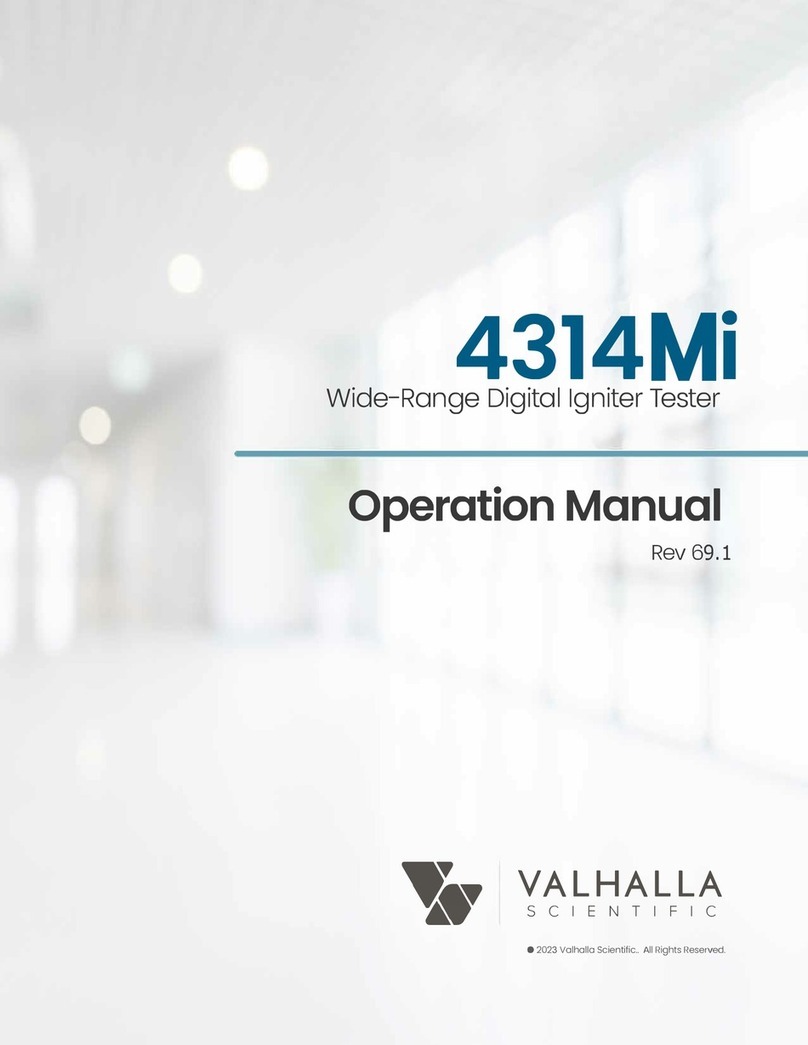
Valhalla Scientific
Valhalla Scientific 4314Mi Operation manual
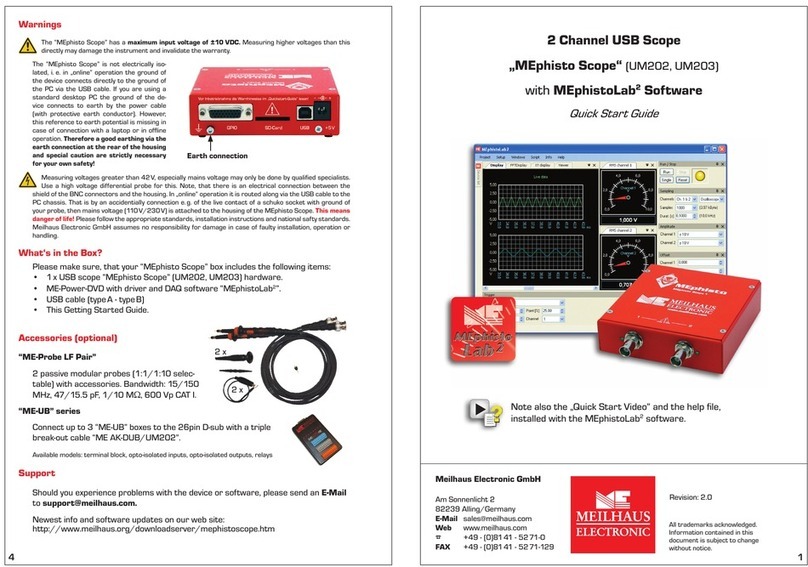
Meilhaus Electronic
Meilhaus Electronic MEphisto Scope UM202 quick start guide
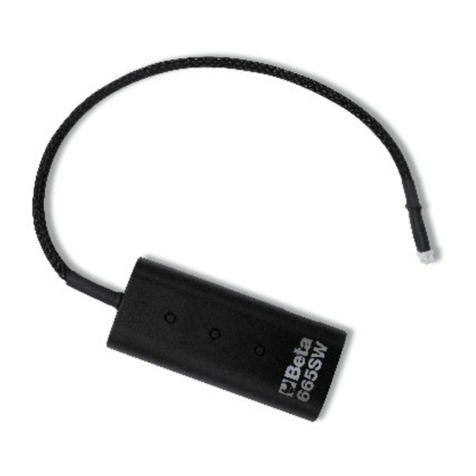
Beta
Beta 665SW Instructions for use
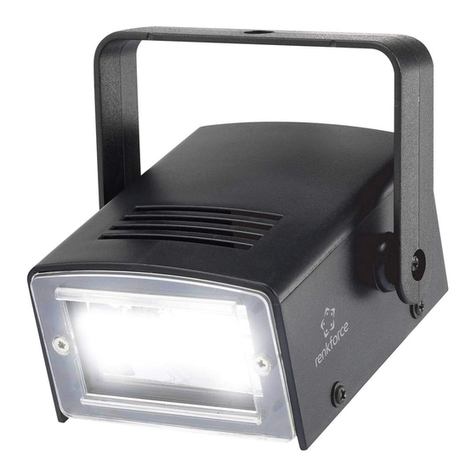
Renkforce
Renkforce TM-SL-M1 operating instructions
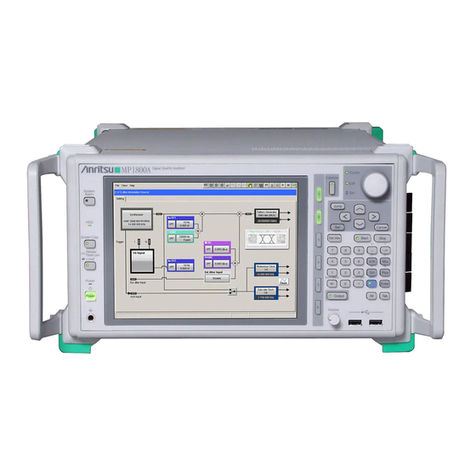
Anritsu
Anritsu MP1800A Operation manual

VOLTCRAFT
VOLTCRAFT VC-65 SE operating instructions
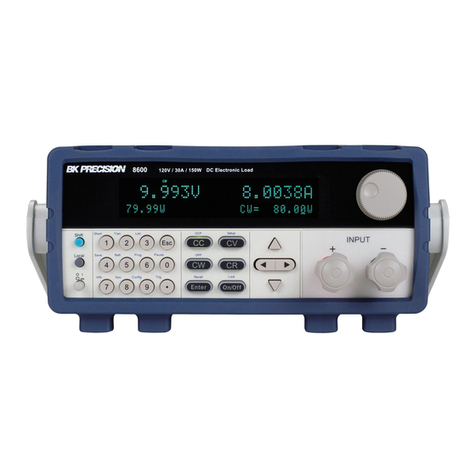
B+K precision
B+K precision 8600 Series user manual
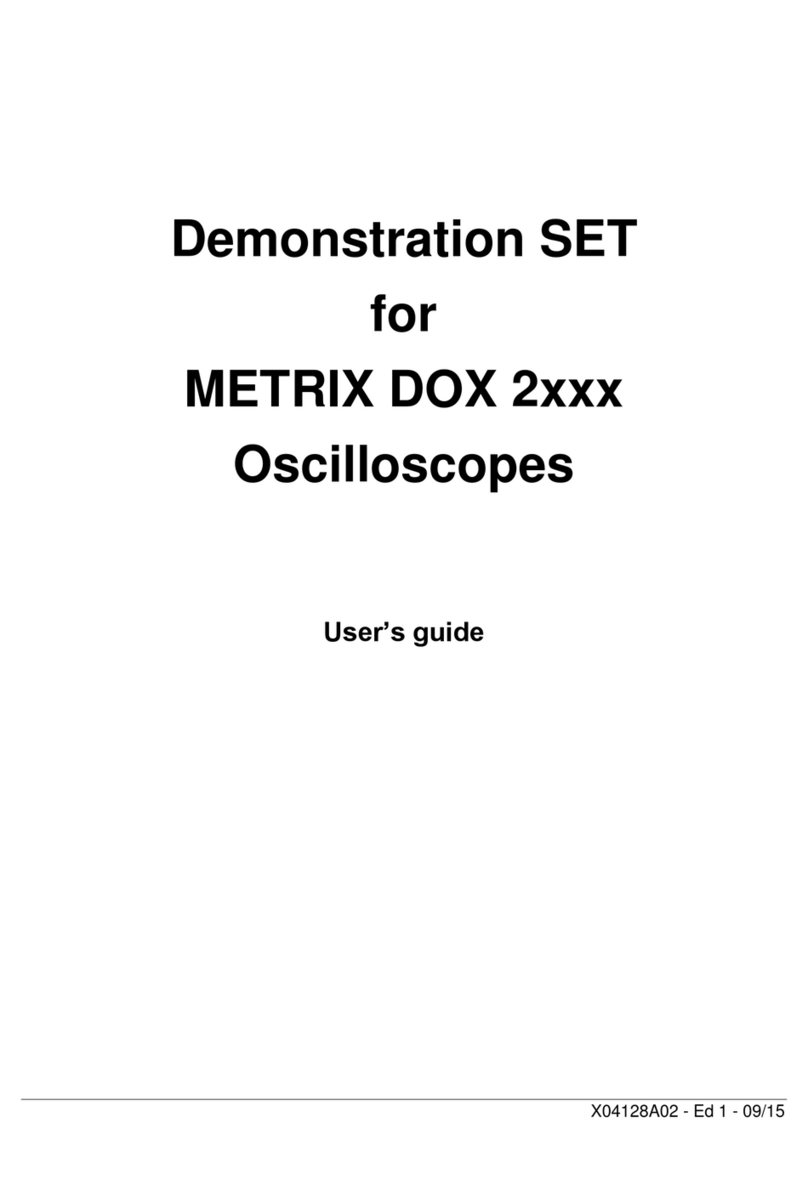
Metrix
Metrix DOX 2 Series user guide
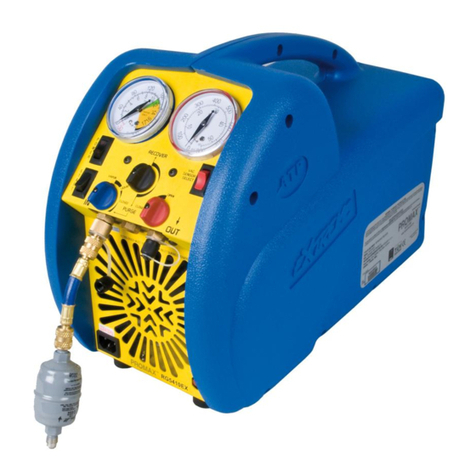
Promax
Promax RG5410A-EXTREME User's operating manual

HIK VISION
HIK VISION IPC-4300H user manual
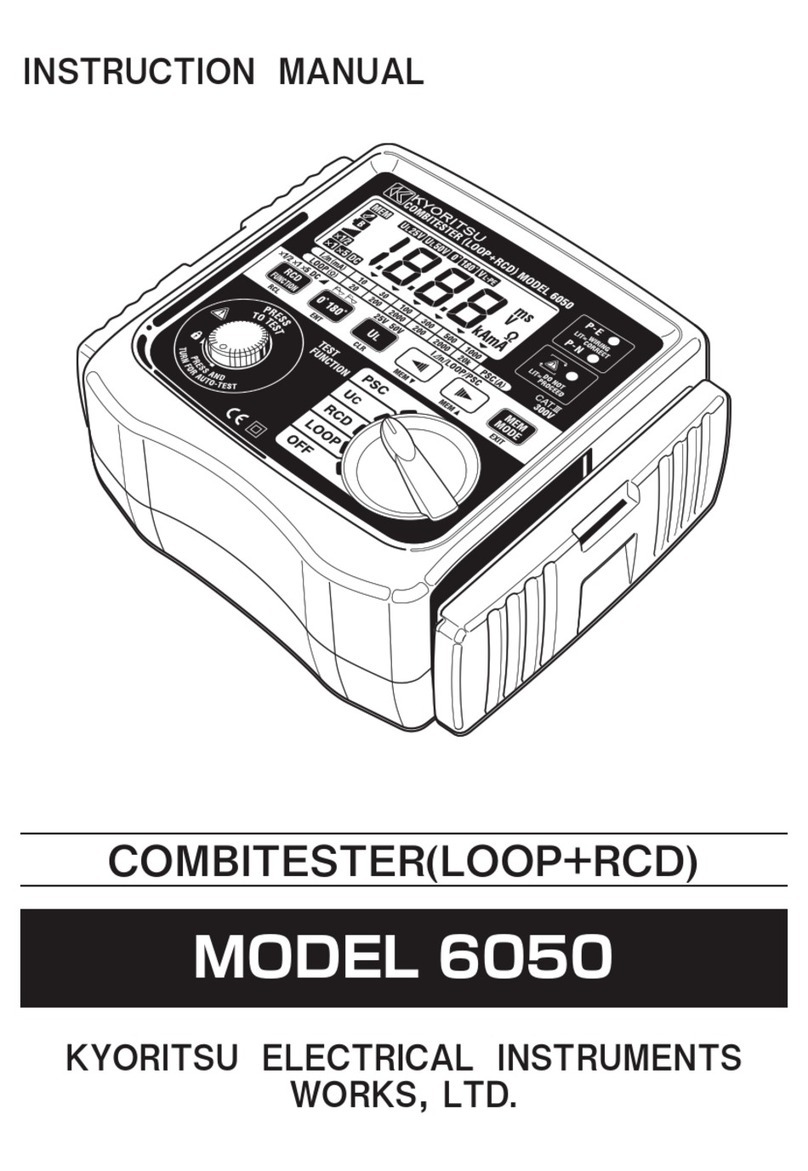
Kyoritsu Electrical Instruments Works, Ltd.
Kyoritsu Electrical Instruments Works, Ltd. 6050 instruction manual
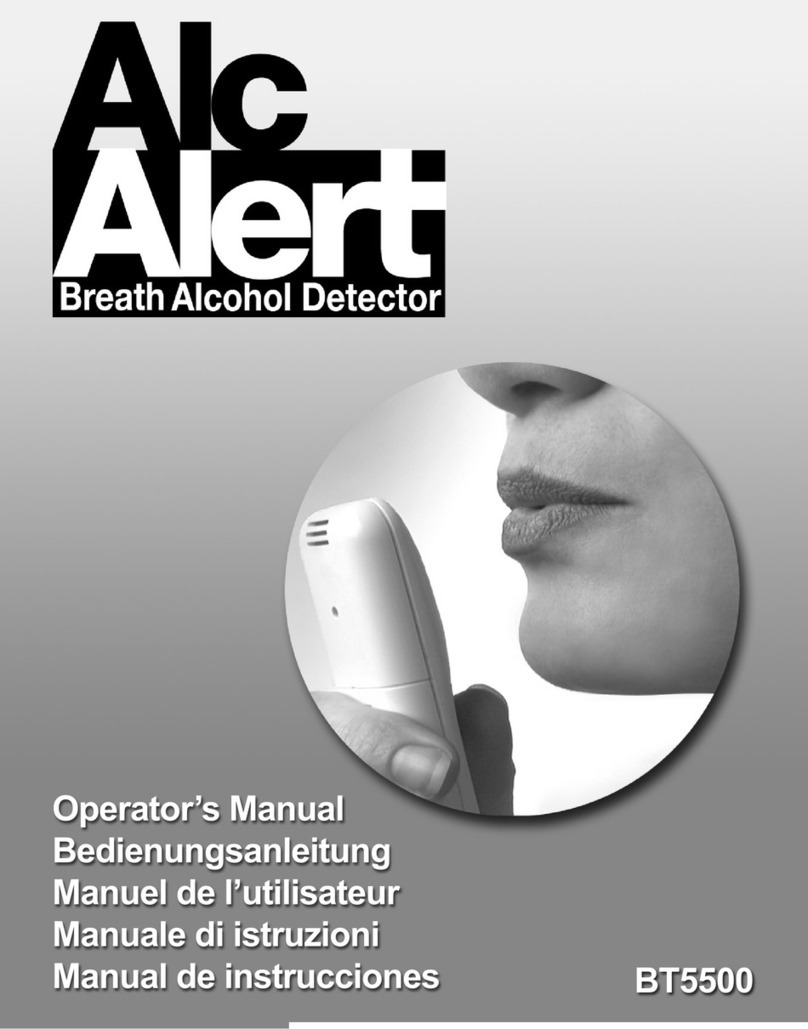
ALC Alert
ALC Alert BT5500 Operator's manual
